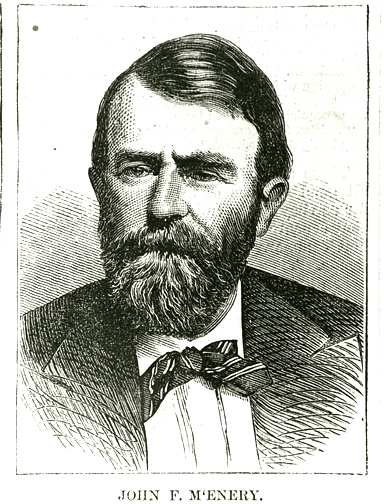Cruikshank Case
With the 1876 Cruikshank Case decision, the US Supreme Court restricted rights protected under the Thirteenth, Fourteenth, and Fifteenth Amendments.

Courtesy of The Historic New Orleans Collection
John McEnery. Unidentified
Abraham Lincoln’s Gettysburg Address in November 1863, along with Reconstruction’s three amendments, gave the country a fundamentally new constitution. The Thirteenth (1865), Fourteenth (1868), and Fifteenth (1870) Amendments abolished slavery, gave black males civil rights and the vote, and, more importantly, established a national citizenship whose rights, protected by the federal government, were to be enjoyed by all Americans. But the US Supreme Court—beginning in 1873 with the Slaughterhouse decision and continuing with the Cruikshank decision in 1876—restricted the rights protected under these amendments. The United States v. Cruikshank case arose from the Colfax Massacre, the bloodiest act of terrorism during Reconstruction.
The Situation
Louisiana’s 1872 gubernatorial election produced two rival claimants for the office: Democrat John McEnery and Republican William Pitt Kellogg. President Ulysses S. Grant and his administration declared Kellogg the rightful claimant. But the election, full of fraud and intimidation, incited turmoil all over the state. In the small village of Colfax, 220 miles northwest of New Orleans, a Democrat and a Republican each claimed to have won the office of sheriff. Kellogg sent rifles to the Republican claimant in order to arm his black followers. The Democratic claimant and his supporters, all white, launched an attack on the Republicans as they conducted a meeting in the courthouse. When the Republicans inside refused to stop the meeting and leave, the Democrats torched the building. Many gathered inside died, and those who fled were shot. The twenty or so who survived the fire and the shootings were jailed. The next night, even those survivors were killed in cold blood. No one is certain how many black men died; the number ranges from a low of 60 to a high of 250. In 1950 the Louisiana Department of Commerce and Industry installed a plaque that reads, “On this site occurred the Colfax Riot in which three white men and 150 Negroes were slain. The event on April 13, 1873 marked the end of carpetbag misrule in the South.” The message engraved on a twelve-foot-tall marble obelisk in the Colfax white cemetery provides a more accurate description of the motivation for the violence: “In loving remembrance/Erected to the memory of the [three] heroes … who fell in the Colfax Riot fighting for white supremacy. April 13, 1873.”
The Trial
Nine white men, accused of having taken part in the massacre, were arrested and put on trial in federal court in New Orleans. They were charged not with murder but with having deprived the murdered men of their civil rights, as enumerated in the Enforcement Act of 1870. After an initial mistrial, a second trial convicted four of the nine men, including William B. Cruikshank. The conviction was appealed and heard by the US Circuit of Appeals. Because the circuit court judges disagreed over the matter of guilt, the case went to the US Supreme Court.
Finally, on March 27, 1876, almost three years after the massacre, the convictions of Cruikshank and his companions were reversed. Chief Justice Morrison Waite issued the majority opinion. He began with a general statement of principles, citing the Slaughterhouse case: “The same person may be at the same time a citizen of the United States and a citizen of a state.” Then he went on to say that the Fourteenth Amendment gave Congress the power to prohibit states from denying life, liberty, or property without due process of law, but the Colfax murders had been the work of private parties, not the state of Louisiana. The implication was that this case should have been left for adjudication within the court system of Louisiana.
Result
The Cruikshank decision left the federal government all but powerless to protect freedmen, except by the use of troops—and these troops had to be requested by the state legislature or the governor. In fact, James R. Beckwith—US attorney for the District of the Circuit Court of Louisiana and the person who had drawn the initial indictment in the Cruikshank case—wrote to inform the US attorney general that after the Cruikshank matter, various White League organizations in the South had sprung to life and grown influential precisely because of this decision. The Enforcement Act and its proposed application in the Cruikshank case posed a classic instance for which the Fourteenth Amendment and enforcing legislation was devised. The states had defaulted in their duty to protect citizens, so the federal government had to step in. Yet the court argued that the Reconstruction-era amendments only empowered the federal government to prohibit violations of blacks’ rights by states; the responsibility for punishing crimes by individuals rested where it always had—with local and state authorities. The Cruikshank decision therefore gave a green light to acts of terror wherever local officials either could not or would not enforce the law.
